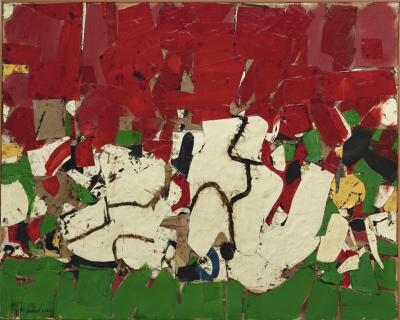Conrad Marca-Relli
American, 1913 - 2000
Marca-Relli is credited with raising collage to the scale and complexity of monumental painting. He was the son of a journalist and he and his family traveled abroad often; he had his first art lessons as a child in Italy. From 1935-38, Marca-Relli worked for the WPA, through which he met de Kooning and Franz Kline, and after World War II moved to New York to study at Cooper Union. For the most part he was a self-taught artist, drawing insight from frequent trips to Italy and looking to artists such as de Chirico, Henri Rousseau and the Abstract Expressionists. Marca-Relli’s approach to collage was unique. He began by sketching forms onto a bare canvas, then arranging them on a new canvas, re-arranging shapes to gain his desired effect. His goal coincided with that of the Abstract Expressionists: to bring accident and gesture to the medium of collage. In the 1960s, he began adding new materials—vinyls, plastics, aluminums, and paper—to his large-scale works. Marca-Relli was included in the 9th Street Show and all of the Stable Gallery Annuals. He joined Koontz Gallery in 1959 and maintained an active teaching career, which included positions at Yale University and the University of California, Berkeley. In 1967, Marca-Relli had a retrospective exhibition at the Whitney Museum of American Art and has been included in exhibitions at the Museum of Modern Art, the Smithsonian Institution, and the Art Institute of Chicago.
conrad-marca-relli art
conrad-marca-relli art
Conrad Marca-Relli, a member of the New York School’s first generation, was a pioneer of Abstract Expressionism. He is most celebrated for his large-scale collages, composed of pieces of canvas or natural linen overpainted with gestural brushstrokes. In 1967, William Agee, then curator at the Whitney Museum of American Art, praised Marca-Relli’s work, claiming that his “achievement has been to raise collage to a scale and complexity equal to that of monumental painting.”
Born in Boston on June 5, 1913, to Italian immigrant parents, Marca-Relli was a primarily self-taught artist and an inveterate traveler who bridged the American and European art worlds. He spent much of his childhood moving back and forth between the United States and Europe; his father was a news commentator and a journalist whose assignments required frequent travel. When he was thirteen, Marca-Relli and his parents permanently settled in New York, where he began his first formal artistic training. With the encouragement of his father, he took night classes at a private art school. After finishing high school in 1930, he studied at the Cooper Union for a year before establishing his own studio in Greenwich Village. During the Depression, Marca-Relli, like many American artists, supported himself by working for the Works Progress Administration (WPA), first as a teacher and then with the easel and mural painting divisions of the Federal Art Project. At this time, he came into contact with progressive artists, including Franz Kline, Willem de Kooning, and John Graham, who exposed him to modernist artistic trends.
After serving in the army during World War II, Marca-Relli returned to New York and to painting. He initially depicted cityscapes and carnival scenes in a Surrealist style, influenced by the work of Giorgio de Chirico, Henri Rousseau, and Joan Miró, before turning to a more abstract style in the early 1950s.
On a trip to Mexico in 1952, Marca-Relli radically altered his artistic practice in response to his surroundings. A probably apocryphal story claims that a lack of paint stimulated his initial experimentation with collage at this time; however, the artist’s account states that he turned to this pictorial technique to solve technical problems related to his interest in capturing the effects of sunlight on adobe buildings. Juxtaposing pieces of light-colored canvas allowed him to define the edges of his forms and establish a sense of depth in largely white-on-white pictures. Furthermore, the collage process enabled him to work quickly and change his creation constantly since he did not have to wait for the paint to dry.
Marca-Relli initially used collage for both architectural themes and a series of single figure images inspired by de Kooning’s depictions of women. As he mastered this technique, he made more complex and dynamic pictures with multiple figures and abstract works with veiled references to architectural and landscape elements. In the early 1960s he continued to explore his interest in abstract forms and began experimenting with new materials, including metals and synthetic plastics.
During the late 1940s and early 1950s, Marca-Relli was actively involved in the avant-garde art world in Greenwich Village. He helped to found the “Eighth Street Club,” an artists’ group whose members included de Kooning, Kline, and Jack Tworkov, and he assisted the art dealer Leo Castelli in the organization of the first “Ninth Street Show,” arguably the first comprehensive display of Abstract Expressionist work. At this time, he achieved much success, and his paintings entered the collections of the Guggenheim Museum, the Metropolitan Museum of Art, the Museum of Modern Art, and the Whitney Museum of American Art. In 1953, he purchased a house near Jackson Pollock’s home in Springs, East Hampton, an area that was developing into an artists’ colony. Three years later, Marca-Relli identified Pollock’s body for the police after his fatal car accident. This experience moved him to paint The Death of Jackson Pollock in that same year.
As his career progressed, Marca-Relli increasingly distanced himself from the New York School. He lived and worked in London; Sarasota, Florida; Wayne, New Jersey; Ibiza, Spain; Paris; and Rome. He maintained a close, lifelong connection to Italy and its art world. Early in his career, he arranged contacts for de Kooning, Castelli, and the art critic Thomas B. Hess in Rome, and in his final years, he lived in Parma with his wife, Anita Gibson, whom he married in 1951. Marca-Relli became an honorary Italian citizen the year before his death in 2000.
Born in Boston on June 5, 1913, to Italian immigrant parents, Marca-Relli was a primarily self-taught artist and an inveterate traveler who bridged the American and European art worlds. He spent much of his childhood moving back and forth between the United States and Europe; his father was a news commentator and a journalist whose assignments required frequent travel. When he was thirteen, Marca-Relli and his parents permanently settled in New York, where he began his first formal artistic training. With the encouragement of his father, he took night classes at a private art school. After finishing high school in 1930, he studied at the Cooper Union for a year before establishing his own studio in Greenwich Village. During the Depression, Marca-Relli, like many American artists, supported himself by working for the Works Progress Administration (WPA), first as a teacher and then with the easel and mural painting divisions of the Federal Art Project. At this time, he came into contact with progressive artists, including Franz Kline, Willem de Kooning, and John Graham, who exposed him to modernist artistic trends.
After serving in the army during World War II, Marca-Relli returned to New York and to painting. He initially depicted cityscapes and carnival scenes in a Surrealist style, influenced by the work of Giorgio de Chirico, Henri Rousseau, and Joan Miró, before turning to a more abstract style in the early 1950s.
On a trip to Mexico in 1952, Marca-Relli radically altered his artistic practice in response to his surroundings. A probably apocryphal story claims that a lack of paint stimulated his initial experimentation with collage at this time; however, the artist’s account states that he turned to this pictorial technique to solve technical problems related to his interest in capturing the effects of sunlight on adobe buildings. Juxtaposing pieces of light-colored canvas allowed him to define the edges of his forms and establish a sense of depth in largely white-on-white pictures. Furthermore, the collage process enabled him to work quickly and change his creation constantly since he did not have to wait for the paint to dry.
Marca-Relli initially used collage for both architectural themes and a series of single figure images inspired by de Kooning’s depictions of women. As he mastered this technique, he made more complex and dynamic pictures with multiple figures and abstract works with veiled references to architectural and landscape elements. In the early 1960s he continued to explore his interest in abstract forms and began experimenting with new materials, including metals and synthetic plastics.
During the late 1940s and early 1950s, Marca-Relli was actively involved in the avant-garde art world in Greenwich Village. He helped to found the “Eighth Street Club,” an artists’ group whose members included de Kooning, Kline, and Jack Tworkov, and he assisted the art dealer Leo Castelli in the organization of the first “Ninth Street Show,” arguably the first comprehensive display of Abstract Expressionist work. At this time, he achieved much success, and his paintings entered the collections of the Guggenheim Museum, the Metropolitan Museum of Art, the Museum of Modern Art, and the Whitney Museum of American Art. In 1953, he purchased a house near Jackson Pollock’s home in Springs, East Hampton, an area that was developing into an artists’ colony. Three years later, Marca-Relli identified Pollock’s body for the police after his fatal car accident. This experience moved him to paint The Death of Jackson Pollock in that same year.
As his career progressed, Marca-Relli increasingly distanced himself from the New York School. He lived and worked in London; Sarasota, Florida; Wayne, New Jersey; Ibiza, Spain; Paris; and Rome. He maintained a close, lifelong connection to Italy and its art world. Early in his career, he arranged contacts for de Kooning, Castelli, and the art critic Thomas B. Hess in Rome, and in his final years, he lived in Parma with his wife, Anita Gibson, whom he married in 1951. Marca-Relli became an honorary Italian citizen the year before his death in 2000.
Conrad Marca-Relli is a master collage artist who studied at Copper Union, NYC. He began his career as a WPA artist (1935-38) but by the early 1940s he began producing surreal landscapes in a subdued palette with architectural starkness, evoking a sense of loneliness and emptiness typical of Surrealists. In 1953 Marca-Relli began experimenting in making collages by sketching forms on canvas, cutting them out then rearranging and pinning them down on another canvas, adding paint to the cut out forms. The paintings of the 1950s were characterized by abstract or suggested figures in reclining or sitting positions. He used intense color, broken surfaces and expressionistic spattering in these collages. In the 1960s Marca-Relli added materials like vinyl, plastic and aluminum to his large scale works. He exhibited frequently in NYC, Europe and Latin America and taught at Yale (54-55, 59-60) and the University of California at Berkley. Marca-Relli's retrospective was held in 1967 at the Whitney Museum of American Art, NYC.
Biography courtesy of The Caldwell Gallery, www.antiquesandfineart.com/caldwell
Biography courtesy of The Caldwell Gallery, www.antiquesandfineart.com/caldwell
